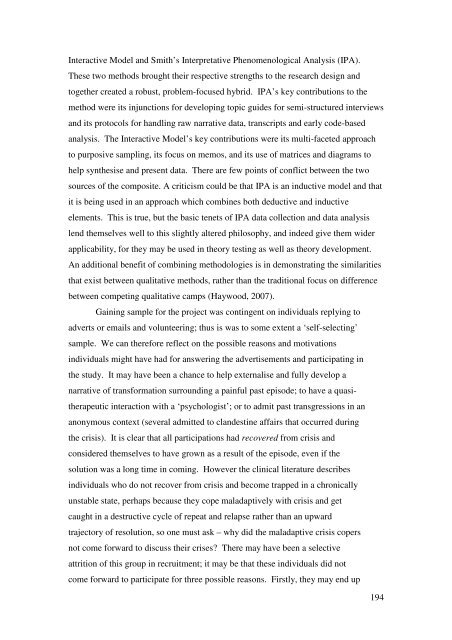DEVELOPMENTAL CRISIS IN EARLY ADULTHOOD: A ...
DEVELOPMENTAL CRISIS IN EARLY ADULTHOOD: A ...
DEVELOPMENTAL CRISIS IN EARLY ADULTHOOD: A ...
Create successful ePaper yourself
Turn your PDF publications into a flip-book with our unique Google optimized e-Paper software.
Interactive Model and Smith’s Interpretative Phenomenological Analysis (IPA).<br />
These two methods brought their respective strengths to the research design and<br />
together created a robust, problem-focused hybrid. IPA’s key contributions to the<br />
method were its injunctions for developing topic guides for semi-structured interviews<br />
and its protocols for handling raw narrative data, transcripts and early code-based<br />
analysis. The Interactive Model’s key contributions were its multi-faceted approach<br />
to purposive sampling, its focus on memos, and its use of matrices and diagrams to<br />
help synthesise and present data. There are few points of conflict between the two<br />
sources of the composite. A criticism could be that IPA is an inductive model and that<br />
it is being used in an approach which combines both deductive and inductive<br />
elements. This is true, but the basic tenets of IPA data collection and data analysis<br />
lend themselves well to this slightly altered philosophy, and indeed give them wider<br />
applicability, for they may be used in theory testing as well as theory development.<br />
An additional benefit of combining methodologies is in demonstrating the similarities<br />
that exist between qualitative methods, rather than the traditional focus on difference<br />
between competing qualitative camps (Haywood, 2007).<br />
Gaining sample for the project was contingent on individuals replying to<br />
adverts or emails and volunteering; thus is was to some extent a ‘self-selecting’<br />
sample. We can therefore reflect on the possible reasons and motivations<br />
individuals might have had for answering the advertisements and participating in<br />
the study. It may have been a chance to help externalise and fully develop a<br />
narrative of transformation surrounding a painful past episode; to have a quasitherapeutic<br />
interaction with a ‘psychologist’; or to admit past transgressions in an<br />
anonymous context (several admitted to clandestine affairs that occurred during<br />
the crisis). It is clear that all participations had recovered from crisis and<br />
considered themselves to have grown as a result of the episode, even if the<br />
solution was a long time in coming. However the clinical literature describes<br />
individuals who do not recover from crisis and become trapped in a chronically<br />
unstable state, perhaps because they cope maladaptively with crisis and get<br />
caught in a destructive cycle of repeat and relapse rather than an upward<br />
trajectory of resolution, so one must ask – why did the maladaptive crisis copers<br />
not come forward to discuss their crises? There may have been a selective<br />
attrition of this group in recruitment; it may be that these individuals did not<br />
come forward to participate for three possible reasons. Firstly, they may end up<br />
194
















